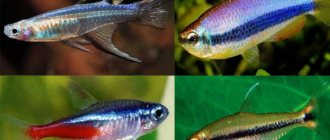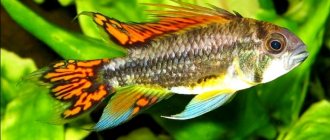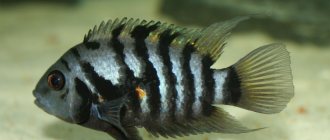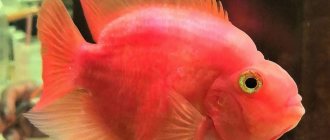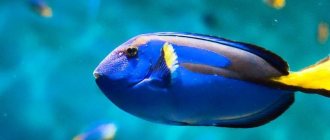Blue neons are hardy fish, but they are sensitive to changes in water chemistry, temperature, stress or disease. All this happens simultaneously during the purchase of the fish at the pet store and the trip home, so neon is very sensitive during the first week in its new home. Therefore it often happens that Neons are dying after purchasing from a pet store. So why are neons dying? Let's look at the main reasons.
Blue neons in a flock
History of the discovery of the species
Neons owe their current popularity to the French explorer Auguste Rabot, who was the first to draw attention to small luminous fish swimming in the Putumayo River. He was so attracted by the unusual beauty of the inhabitants of the reservoir that he decided to start exporting them.
In 1935, the first neons were transported to the USA and Europe, where they immediately captivated local aquarists. The fish immediately became mega-popular, and Rabo became their only supplier to the New and Old Worlds. The business of the enterprising Frenchman also flourished because neons could not be bred in captivity for a long time.
Some of the first luminous fish were given as a gift to William Innesi, and he shared them with his friend George Myers. It was the latter who was the first to make a scientific description of ordinary or blue neon and named it in honor of his friend - Hyphessobrycon innesi. The species was later renamed Paracheirodon innesi.
Red neons were discovered only in the middle of the 20th century. Moreover, their description was made by two scientists at once, Schultz and Myers. But the work of the first was published earlier, so the species received the name given to him - Paracheirodon axelrodi.
In 1963, Jacques Gehry discovered emerald neon, also called simulant neon. The fish he discovered was similar to the red neon, but in the course of further research it was classified as a separate species.
The first offspring from neons living in captivity were obtained in Germany thanks to a happy accident. The fact is that in this country very soft water flows from the taps, which is used to keep fish. The first spawning of neon in captivity was dubbed the “German miracle,” but as a result of the study, experts discovered a connection between water parameters and the reproduction of Paracheirodon.
Housing issues
Although maintaining blue neon does not require extreme effort, the lifespan of your pet directly depends on how well the aquarium is equipped. The most important thing here is degrees. In the rivers of South America, the water temperature is 20-26 degrees, and in this matter the nature of the fish is very categorical.
Exceeding the last mark by a single degree can halve your pet's life ! The higher the water temperature, the faster the fish’s biorhythms will circulate. Therefore, for neon, 18 degrees will be more useful than 27.
It is better to choose a spacious aquarium for neons. The presence of thickets will allow neons to hide and feel more protected.
But the hydrochemistry of a neon dwelling is not so harmful to fish. When the rainy season begins in the natural environment, the reservoirs are “diluted” with soft and not at all acidic water. Therefore, neon fish are unpretentious to the chemical parameters of their habitat; the fish tolerate an increase in nitrites and nitrates well. But experts advise not to experiment and always maintain the pH at 5.0 - 7.0, and the hardness within 1-2 dH. It is also not recommended to add fresh water in large portions. Better more often, but little by little.
The aquarium should not be cramped - active fish need to move and make “crosses”. Therefore, it is not recommended to plant even a small flock in a container of less than 10 liters. You don't have to cover the aquarium - the fish don't tend to jump out. Moderate lighting is needed; the fish should have shaded shelters in the thickets of plants. Neons, by the way, treat vegetation with care and do not spoil it. It is better to line the bottom with peat or basalt chips. Stones and snags will come in handy, but without fanaticism - the fish should not hit obstacles when it wants to swim freely.
Habitat
The natural habitat of neons is South America. Schools of luminous fish inhabit the basins of the Rio Tacuari, Paraguay and Brasil rivers. They do not like fast currents and are found in slow-flowing tributaries of large rivers, the water of which contains high concentrations of humic substances, giving it a brown tint.
Due to the fact that these rivers flow mainly under the canopy of tropical rainforests, twilight reigns in their depths. A thick layer of silt, regular rains and rotting leaves make the water sour and soft.
Neon's tumor: signs, causes, treatment, prevention
There are benign and malignant neoplasms. Melanosarcoma is one of the most dangerous for Neons, malignant, leading to a tumor of pigment cells. The fish's torso becomes black, so it is easy to recognize. If the growth is small and has affected the internal organs of the fish, then it is possible to find out about it only by cutting the body.
Benign tumors cause little harm to the fish; they grow slowly and do not damage the tissue. But malignant ones arise in them and metastasize.
The causes of tumors are the chemical and physical parameters of the aquarium environment:
- viruses;
- genetic code;
- strong ionizing radiation.
All types of tumors are incurable, so there is no cure. It is better to kill a sick individual.
To prevent this disease, it is better to place the aquarium away from sources of ultraviolet and x-ray radiation. Avoid getting carcinogenic and toxic substances into the water.
general description
Neons are small schooling fish, the length of which does not exceed 4-5 cm. They have an elongated body, slightly flattened on the sides, a small mouth and transparent fins. Moreover, the dorsal one is shorter than the anal one.
Like other members of the characin family, neons have an additional fin. It is located immediately behind the spinal cord and consists exclusively of adipose tissue. The body of each fish is decorated with a longitudinal reflective strip, creating a glowing effect.
It consists of special cells - chromatophores - hidden under the scales.
Basic diseases and their prevention
Pisces, like any other pets, can get sick. It is necessary to regularly monitor their behavior and appearance in order to stop the infection in time and carry out preventive measures.
In addition to infections, diseases can be associated with violation of living conditions.
Here are the most common diseases:
- White-skinned. If fish lose color, then the reason may be this bacterial disease. For treatment, sick individuals are temporarily moved to a separate container with a solution of chloramphenicol. The main aquarium needs to be disinfected.
- Deformed fins. This is a sign of fin rot, a bacterial disease caused by damage to the body. The algorithm of actions is the same as for the previous disease.
- Plistophorosis. A terrible disease for neons. Loss of coordination of the fish and its strange behavior is a direct sign of infection. It is impossible to cure the disease; the only way out is to destroy the diseased fish and thoroughly clean the aquarium.
Of course, this is not the entire list of possible diseases, but only the most popular of them. In order to avoid unnecessary problems and the death of your beloved pets, you need to regularly carry out preventive maintenance. It is important to disinfect everything that is placed in the aquarium, treat new flora with a light solution of potassium permanganate (light pink), and also use special devices to monitor water parameters. If all simple rules are followed, neons will give a lot of pleasant impressions with their bright appearance and cheerful “pirouettes” in the aquarium.
Varieties
Now there are many varieties of neons, differing in body color.
Diamond
An artificially bred species of neon with a light, almost white body and a red tip of the tail. Unlike representatives of other species, these fish do not have a luminous stripe.
Orange
Rare, artificially bred fish, related to red neons. They are colored light orange and have a pale blue neon stripe.
Red
These fish grow up to 45 mm long and have interesting colors. Their back is olive-beige, and their belly is completely red. A bright, color-changing stripe runs down the middle of the body.
Gold
The smallest of all neons, growing up to 15 mm long. They are painted in a bright golden color and have a light luminous stripe.
Violet
This type of neon is also known as pink. The scales of the fish are colored purple or pink, and in the middle of their body there is a clear blue stripe.
Green
Small, hardy fish with bluish-green scales that shimmer in the light. They are rarely bred in artificial reservoirs and are caught from South American rivers. Green neons tolerate changing natural conditions well in the home aquarium and live in water that is not too hard and has a low acidity level.
Black
Quite large fish, growing up to 4 cm in length. The back of black neons is painted in a delicate olive shade, and in the middle of the body there is a bright yellowish-white stripe. The lower part of the body of the fish shimmers from dark green, almost black, to a silvery hue.
Blue (regular)
The most popular variety of neons, often found in home aquariums. The color of their body is dominated by a bluish-gray tint, and the abdomen is tinted red.
Blue
This species of fish was developed by crossing blue and red neons. Their slender bodies are painted in dark shades, and a clear blue stripe runs down the center.
Neon disease
The characteristic color of neon and its damage as a result of a characteristic disease gave it its name: neon disease. It was on blue and green neons that it was discovered. The causative agent is the microsporidia Pleistophora hyphessobryconis. Penetrating into the fish along with ingested food, this parasite begins active invasion.
Stop coccid
Pulcox
As a result, within a month, white dense inclusions form inside the muscle tissue. The bright color of the neons fades, the scales in the area of the dorsal and caudal fin begin to come off. The fish becomes lethargic and inactive, loses appetite and dies.
There is no clear cure for pleistophorosis (the scientific name for neon disease). You can use drugs such as “Stop-coccid” or “Pulcox”, but they are not guaranteed to cure the fish. The main means of combating is careful observation. At the slightest suspicion, the fish should be quarantined. Those who are seriously ill will have to be destroyed, and the volume of replacement water in the aquarium will have to be increased.
[ads2]
Care and maintenance
Neons are fairly unpretentious and hardy fish, quite suitable for home keeping. They are sensitive to sudden changes in water parameters and cannot live in an aquarium that has not completed the nitrogen cycle. It is better to release neons into an existing reservoir with an established biological balance.
Aquarium
Neons are social fish that lead a school life. When kept alone or in pairs, they lose tone and color. Therefore, it is better to place them in the aquarium in small groups of up to 6-8 individuals. The volume of the tank is selected on the basis that there should be 2-3 liters for each fish.
The shape of the aquarium can be rectangular or square and preferably with low sides. It is not necessary to have a lid on the tank, since neons rarely jump out.
Water
Neons are not too picky about water quality and prefer tanks with an already established balance. To make glowing fish as comfortable as possible in captivity, the liquid in the aquarium must meet the following parameters:
- temperature – 23-25 0C;
- acidity – 5.5-5.7;
- hardness – 8-10.
The lower the temperature of the aquatic environment in the aquarium, the longer the neons will live. Once a week, you need to change 25-30% of the total water volume in the tank. To create a “black water” effect reminiscent of natural water, Tetra ToruMin conditioner can be added to it.
Equipment
An aquarium with neons must be equipped with a filter for biological and mechanical water purification. The power of the device is selected individually, taking into account the volume of the tank. A compressor wouldn't hurt either.
Neons like dim lighting. Bright light makes fish want to hide and puts them into a state of stress. Therefore, in an aquarium with neon lights, too powerful lamps are not needed.
Ground and decorations
To emphasize the natural beauty of neons, it is better to add a dark substrate to the aquarium with them. It can be basalt, a special type of sand or pebbles.
Any decorations can be used. The main thing is that they serve as a good shelter for luminous fish. These can be stones, driftwood, shards and various labyrinths.
Plants
Neons like to hide in algae, so there should be plenty of greenery in the aquarium. The best option would be various types of moss, hornwort, vallisneria, elodea and cabomba.
On a note. An aquarium with neons must have floating plants, such as riccia or duckweed. They help diffuse light and create additional shadow.
Appearance and gender of the neon fish
It is already clear where the name of the beautiful fish came from - the reason was the treasured stripe. It stretches from the head almost to the tail, in the middle deftly casting a silvery olive color. The red stripe is wider, it starts from the middle of the abdomen and reaches the tail.
The female blue neon has a more rounded shape than the male.
Moreover, in females this line is slightly curved, and the abdomen is more rounded and plump. Males, on the other hand, have a slender, thin body with a perfectly straight neon stripe. And the main pride of a fish – the swim bladder – in “boys” is located closer to the anus. “Girls” wear a bubble in the spine area.
The color of neon can tell a lot about its health and mood. If a fish is sick, its colors immediately lose their brightness, become faded, and the little fish is almost invisible in the gloomy water . Unexpected stress also does not have the best effect on the shades of scales. The fish is naturally shy, and any event can ruin its colors. But you shouldn’t worry at night - neon’s drowsiness is also expressed in the paleness of its scales. By morning, a healthy, joyful pet will again sparkle with bright colors and transparent fins.
The most beautiful aquarium is obtained if you keep a flock of 10-30 neons in it. Dark soil and densely planted plants will highlight the natural beauty of the fish. Large neighbors cannot be placed near neons. Peaceful crumbs will easily become tasty prey for large fish. Aquarium neon fish can live up to 4 years in good and safe conditions.
Features of reproduction
Neons reach sexual maturity by 6 months, and special conditions are required for their reproduction.
Sex differences
Neons have poorly developed sexual dimorphism. But you can distinguish a female from a male by its larger size and slight curvature of the strip on its side.
Preparing for spawning
Males and females are placed in different aquariums in advance and fed only live food for a month. All this time, the water temperature in the tank is maintained at 22 0C, and other parameters are kept as close to natural as possible.
Spawning
A separate 20-liter aquarium with a lid and an aerator that creates very fine bubbles is used as a spawning tank. It is better to lay a tangle of small fishing line, separator mesh or Java moss on the bottom of the tank. And to create moderate lighting, the walls of the aquarium can be covered with paper.
A 15-centimeter layer of distilled water is poured into the tank, the quality of which must meet the following indicators:
- temperature – 24-26 0C;
- acidity – 5-6;
- hardness – 1-2.
In the evening, future spawners are released into the prepared spawning area and given the opportunity to swim calmly. Spawning begins closer to dawn. The female lays up to 200 very small eggs, and the male, not lagging behind, follows her. When the process is completed, the fish are caught with a net and returned to the general aquarium.
The water level in the spawning tank is reduced to 7-10 cm, and aeration and lighting are completely removed, leaving only a small ray of light. To make it more convenient to control the eggs, the substrate is removed from the bottom of the aquarium.
Care of offspring
After 5 days, larvae emerge from the eggs. They rise to the surface to take in air and fill their swim bladder. The larvae feed on ciliates that have accumulated in the illuminated part of the aquarium, and after three days they become fry.
From this moment on, they switch to horizontal swimming and can already feed on Artemia nauplii, and later on small Cyclops.
The water in the aquarium with the fry is changed daily by a third of the total volume, gradually increasing its hardness. By the end of the first month, growing fish can be moved to a common tank.
Compatibility
Neons themselves do not pose any danger to other inhabitants.
However, they can easily become prey for predatory species, so it is better for the following individuals to get along with them:
- platylia,
- guppy,
- cardinals,
- iris,
- swordtails,
- barbs.
An interesting point: you can safely plant angelfish with them, despite their large size, they are not aggressive and do not pose a danger to neons.
Health and life expectancy
With good care, neons live for about 4 years. Poor nutrition, lack of hygiene and constant stress make fish vulnerable to such dangerous diseases as:
- Plistophorosis. The disease develops under the influence of a fungus introduced into an aquarium with infected fish or contaminated water. It is manifested by fading of color and apathy. Sick fish lose their former energy and swim upside down. Plistophorosis cannot be treated, so infected neons are destroyed, and the tank itself is treated with disinfectants.
- Ichthyophthyriosis. Various specks and bumps appear on the body of a sick individual, reminiscent of semolina. Ichthyophthiriasis is treated by increasing the water temperature by a couple of degrees and saturating it with oxygen. If these measures prove to be ineffective, purchased funds are used.
Neons are peaceful, graceful fish with iridescent scales that glow in the dark. They do not require specific care, but are very sensitive to water temperature.
Temperature
A sudden change in water temperature leads to stress, and a bag for transporting fish from a pet store can cool down within 30 minutes, depending on the ambient temperature. It is advisable to have a thermal bag or foam box with you during long-term transportation to slow down the temperature change process. After you bring the neons home, you need to equalize the temperature in the bag with the fish and in your aquarium. To do this, do not open the package for 15 minutes and simply put it to float in your aquarium
